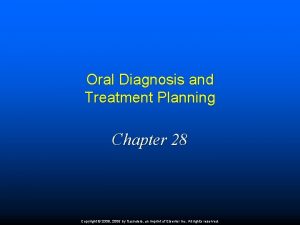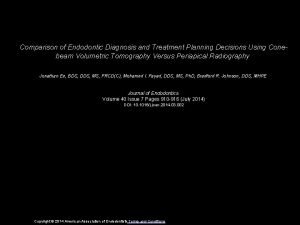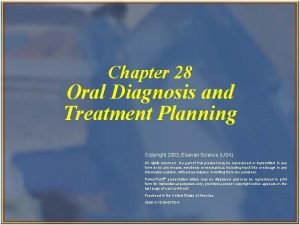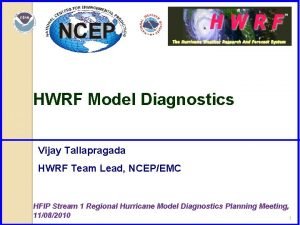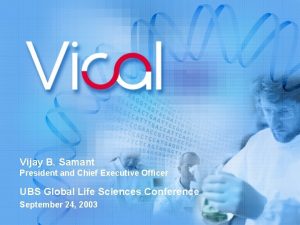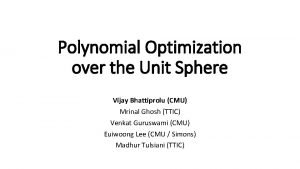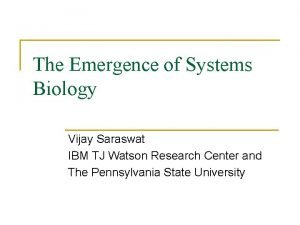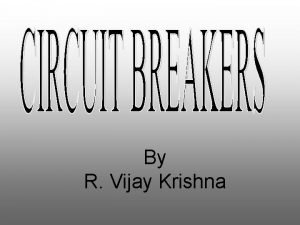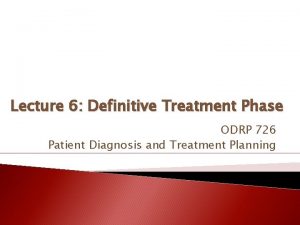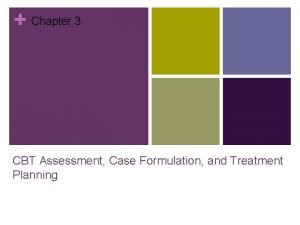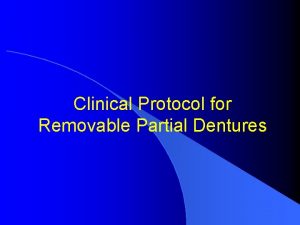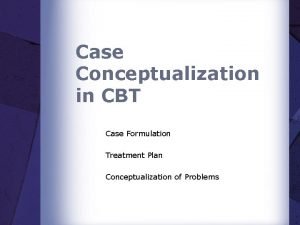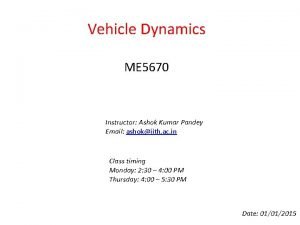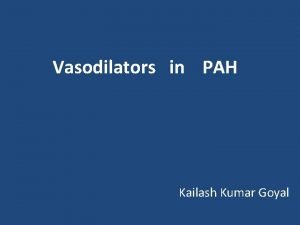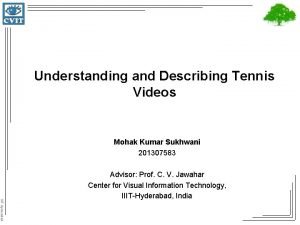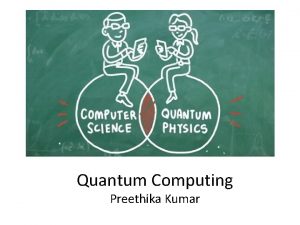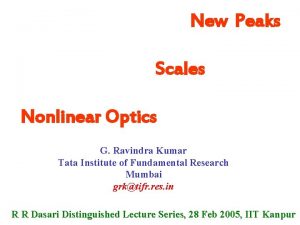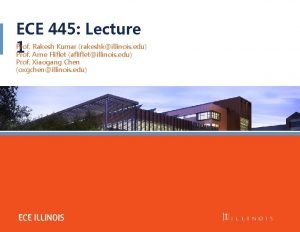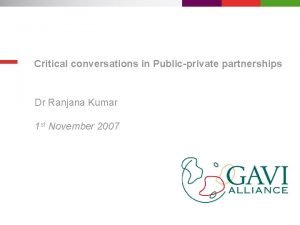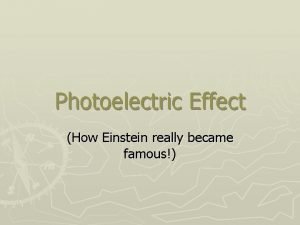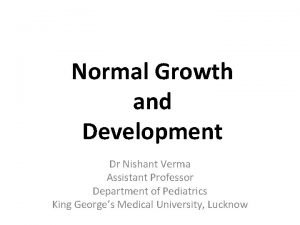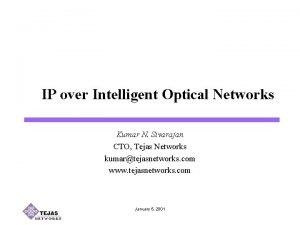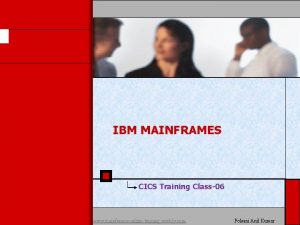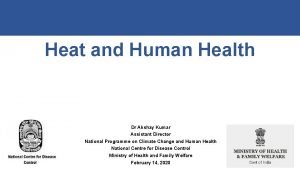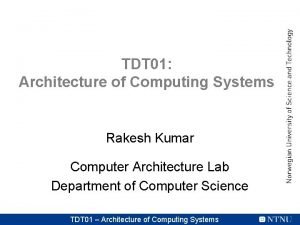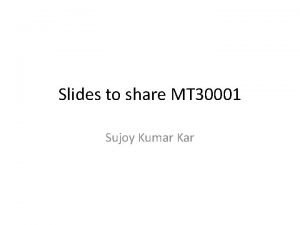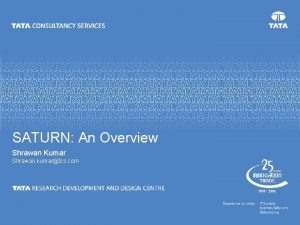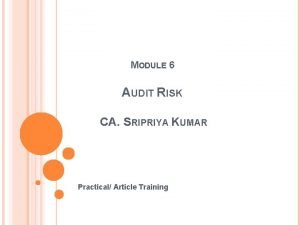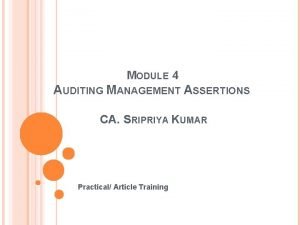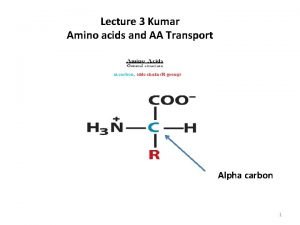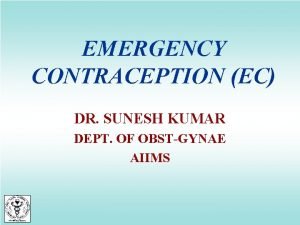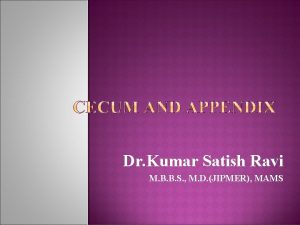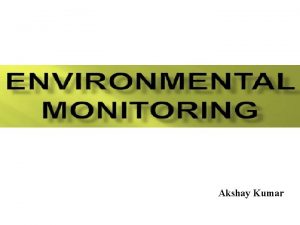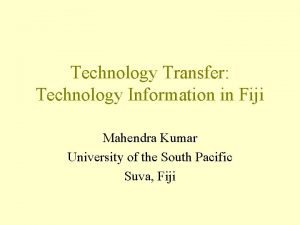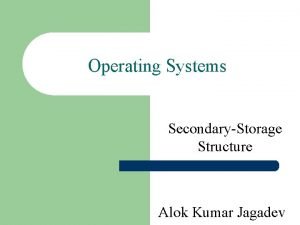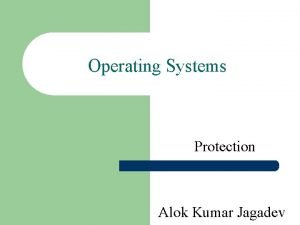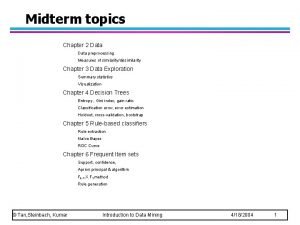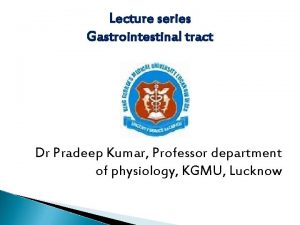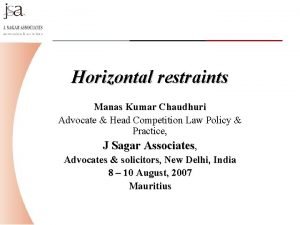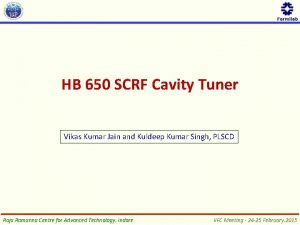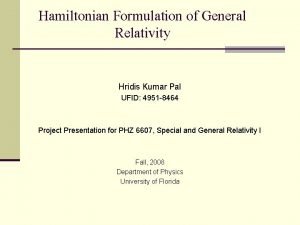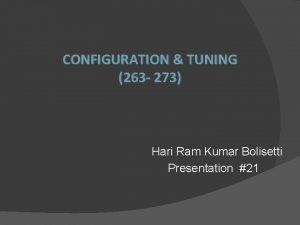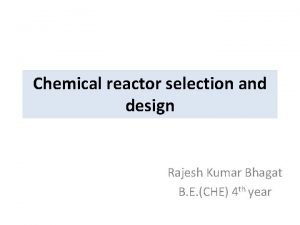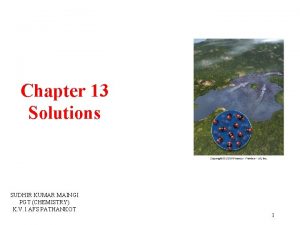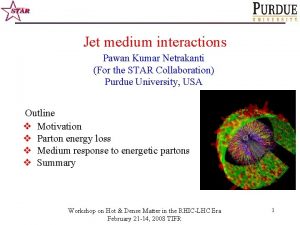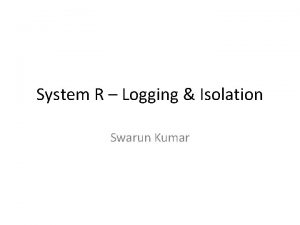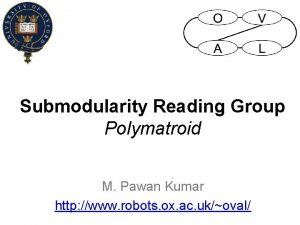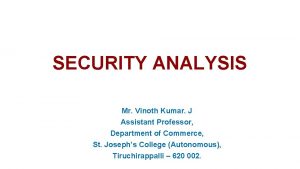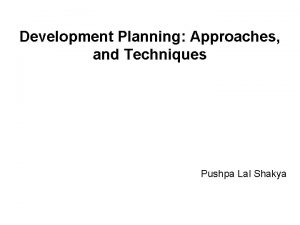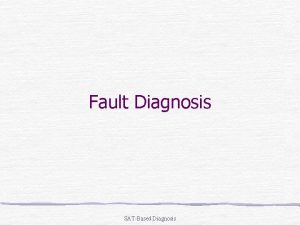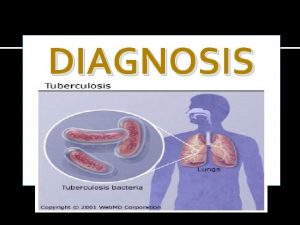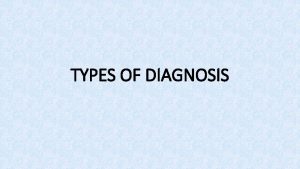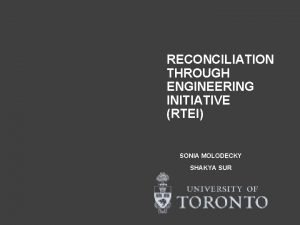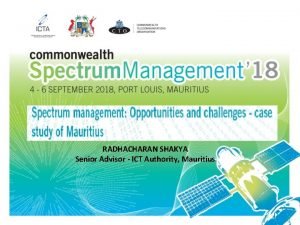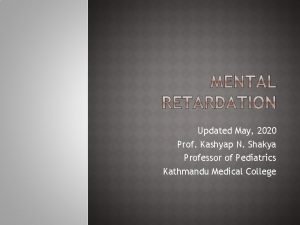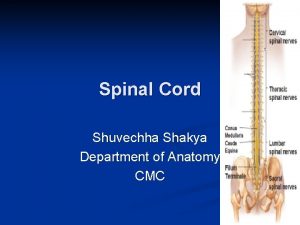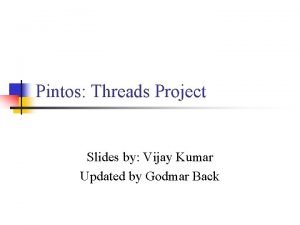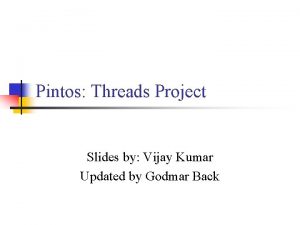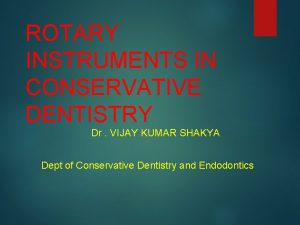DIAGNOSIS TREATMENT PLANNING Dr Vijay Kumar Shakya INTRODUCTION














































































































- Slides: 110

DIAGNOSIS & TREATMENT PLANNING Dr. Vijay Kumar Shakya

INTRODUCTION Many diagnostic aids available which makes diagnosis simple Utilizing skills , experience & knowledge in obtaining the history, any related information & in performing the clinical tests in order to establish a diagnosis Depending on one clinical test solely as it may be misleading

DEFINITION Diagnostic process -as an act of determining a patients health status & evaluating the factors influencing that status Art or act of identifying a disease from its signs & symptoms (MERRIAM-WEBSTER , 2003) Various types of diagnosis. Provisional diagnosis Differential diagnosis Investigative diagnosis Histo -pathological diagnosis Radiographic diagnosis Final diagnosis

CLINICAL DIAGNOSIS “The determination of the nature of a disease made from a study of the sign and symptoms of a disease. ”

Art and Science of diagnosis Chief Complaint Medical history Dental history History of Present Dental problem Dental History Interview

Clinical Examination and Testing Extraoral Exam Intraoral Exam

Radiographic Exam and interpretation Diagnosis

Chief Complaint (CC) Record symptoms or problems expressed by the patient in his or her own words When the patient is unaware of any problem or has been referred for diagnosis or treatment, these fact should also be recorded” no chief complaint” for future reference

Medical History 1. Take a complete medical history for each new patient. 2. Update the medical history of each patient of record at each Treatment (Tx) visit and determine any changes in the Pt’s medical Hx or medication 3. A medical problem could confuse and complicate the Dx of dental pathosis


Medical Conditions That Warrant Modification of Dental Care or Treatment Cardiovascular: High- and moderate-risk categories of endocarditis, pathologic heart murmurs, hypertension, unstable angina pectoris, recent myocardial infarction, cardiac arrhythmias, poorly managed congestive heart failure. Pulmonary: Chronic obstructive pulmonary disease, asthma, Tuberculosis. Gastrointestinal and renal: End-stage renal disease; hemodialysis;

viral hepatitis (types B, C, D, and E); alcoholic liverdisease; peptic ulcer disease; inflammatory bowel disease; pseudomembranous colitis. Hematologic: Sexually transmitted diseases, HIV and AIDS, diabetes mellitus, adrenal insufficiency, hyperthyroidism and hypothyroidism, pregnancy, bleeding disorders, cancer and leukemia, osteoarthritis and rheumatoid arthritis, systemic lupus erythematosus. Neurologic: Cerebrovascular accident, seizure disorders, anxiety, depression and bipolar disorders, presence or history of drug or alcohol abuse, Alzheimer’s disease, schizophrenia, eating disorders, neuralgias, multiple sclerosis, Parkinson’s disease

Dental history - Should include any past and present symptoms, as well as any procedures or trauma that might have evoked the CC - use a premade form to record the pertinent information obtained during the dental Hx interview and diagnostic examination - Attitudes toward dental health and treatment may affect treatment planning.

Present illness Onset: sudden or insidious onset Location: diffused, localized, referred, or radiated Quality: throbbing/dull, sharp or lingering Intensity: mild, moderate, severe Frequency: constant, intermittent, momentary or occasionally Initiated/relieved by….

Dental History interview 5 basic direction of questioning 1. Location-”Can you point to the offending tooth? In some cases the patient may be able to identify 2. Commencement: When did the symptoms first occur? 3. Intensity-How intense is the pain?

4. Provocation and relief of pain: What produces or reduces the symptoms? 5 Duration-Do the symptoms subside shortly, or do they linger after they are provoked ?

Clinical Examination and testing Extraoral Examination a. Check general appearance, skin tone, and facial asymmetry b. Note any swelling, redness, sinus tracts, tender or enlarged lymph nodes, or tenderness or discomfort upon palpation or movement of the TMJ.


Intraoral Exam Soft Tissue -Examine the mucosa and gingival visually and digitally for discoloration, inflammation, ulceration, swelling, and sinus tract formation

Dentition-Examine teeth for discoloration, fracture, abrasion, erosion, caries, large restorations, discoloration or other abnormalities

Palpation Bilateral palpation Note how it compares with and relates to the adjacent and contralateral tissues Question the Pt on any areas that feel unusually sensitive during this palpation part of the Exam

Percussion Digital pressure Tapping with instrument handle -using the back end of a mirror handle Occlusal / Buccal/ Lingual

CLASSIFICATION OF DIAGNOSTIC AIDS CONVENTIONAL VISUAL TACTILE RADIOGRAPHS-IOPA & BITEWING CARIES ACTIVITY TESTS NEWER DIAGNOSTIC AIDS BASED ON DIGITAL RADIOGRAPHY BASED ON VISIBLE LIGHT BASED ON LASER LIGHT MAGNIFICATION

CLASSIFICATION FUTURE TRENDS IN DIAGNOSIS MULTI PHOTON IMAGING INFRA RED THERMOGRAPHY INFRARED FLUORESENCE OPTICAL COHERENCE TOMOGRAPHY ULTRASOUND TERAHERTZ IMAGING

CONVENTIONALDIAGNOSTICAIDS

MOUTH MIRROR Various sizes & types No. 2 to No. 5 (0. 75 -1 inch dia) No. 2 dental mirror provides greater freedom for rotary or hand instrumentation. Especially in posterior segment The dental mirror is used As an operating light deflecting device Means of visualizing the examining area

MOUTH MIRROR The reflective surface of the mirror may be Plain or Magnifying It may reflect from either the front or rear surface Early lesion appear as chalky white , yellow , brown or black discoloration The front surface types are advantageous as the visual distortions are minimized

DENTAL EXPLORER A delicate pointed instrument used for the digital examination of the tooth Restoration surfaces and their margin juncture To enhance tactile discrimination Types-straight explorer, sickle shaped explorer

DENTAL EXPLORER There are three operational factors which are to be considered when selecting an explorer: 1) Sharpness of the point 2) Resilience and stiffness 3) Design of the shank, handle The explorer enables the operator to probe enamel surfaces with some vigour in diagnosing caries

ICDAS A-Preliminary Preparation B- Assessment

Caries Severity 0 -Sound Tooth Structure. 1 -First Visual Change in Enamel 2 -Distict Visual Change in Enamel. 3 -Enamel breakdown, no dentine visible. 4 -Dentinal shadow, no cavitations. 5 -Distict Cavity with visible dentine. 6 -Extensive distinct cavity with visible dentine.


Restorative Status 0 -Not Sealed or restored. 1 -Sealent, partial. 2 -Sealent, Full tooth colored restoration. 3 -Amalgam restoration. 4 -Stainless steel restoration. 5 -Ceramic, Gold, PFM. 6 -Lost broken restoration. 7 -Temporary restoration.

SEPARATORS Orthodontic elastic separators applied for 2 -3 days around contact areas of surfaces Tooth separation have detected more non cavitated enamel lesions than visual tactile examination Established relationship- radiographic lesion depth & presence or absence of cavity formation on contacting approximal surfaces Disadvantages Accessibility for inspection after tooth separation is not always improved as much as needed Use of this technique may cause discomfort Requires an extra visit

RADIOGRAPHS Radiographs are a valuable supplement to a thorough clinical examination of the teeth for detecting caries IOPAR- useful primarily for detecting changes in periapical bone BITE WING-most useful for detecting caries

RADIOGRAPHIC DETECTION OF LESION PROXIMAL SURFACE Early radiolucent lesion in enamel- triangle with broad base at tooth surface At DEJ – spreads along the junction second triangle with apex towards the pulp chamber

Wider base than at enamel , progressing towards pulp along direction of dentinal tubules Lesion commonly found between contact point & free gingival margin Lesion confined to enamel are not evident till 30 - 40% demineralization

OCCLUSAL SURFACE Originates at enamel pits & fissures walls , spreads along enamel rods , penetrates to DEJ perpendicularly(radiolucent line) Occlusal caries in dentin – broad based radiolucent zone , often beneath a fissure , with little or no changes in enamel In dentin the margin between carious & non carious dentin is diffuse & may obscure the radiolucent line at DEJ

BUCCAL & LINGUAL SURFACE These lesion occur in enamel pits & fissures Small- round , they enlarge , they are elliptical or semilunar with sharp well defined borders ROOT SURFACE Involve both cementum & dentin , gingival recession Differ from intact surface- absence of an image of root edge & appearance of diffused rounded inner borders


CARIES ACTIVITY TEST Caries susceptibility tests Status of micro- organisms in oral cavity SNYDER’S TEST Basis- amount of acid produced in a medium no. of acid producing lactobacilli present p. H -5 For indication of change in p. H , evaluation of rapidity & extent of acid production –Bromocresol green

SALIVARY REDUCTACE TEST/ TREATEX TEST Rate at which Diazo Resorcinol color changes from blue- red , red – pink or white or colorless shows caries activity Saliva taken in collection tube till 5 ml calibration mark Mixed with Diazo Resorcinol (reductace enzyme reacts) Color changes in 30 sec & 15 min indicates caries activity Color Time Score Caries activity Blue 15 min 1 Non-conducive Orchid 15 min 2 Slightly conducive Red 15 min 3 Moderately conducive Red Immediately (30 sec) 4 Highly conducive Pink or white Immediately 5 (30 sec) Extremely conducive

NEWERDIAGNOSTICAIDS

XERO RADIOGRAPHY Imaging method was discovered by an American physicist, Chester Carlson in 1937 Pogorzelska-Stronczak the first to use xeroradiograph to produce dental images An electrostatic process which uses- to form a plate Amorphous selenium photoconductor material Vacuum deposited on an aluminium substrate The plate, enclosed in light tight cassette

ADVANTAGES Elimination of accidental film exposure High resolution Simultaneous evaluation of multiple tissues Ease of reviewing Higher latitude of exposure factors Better ease & speed of production Reduced exposure to radiation hazards Wide application

DISADVANTAGES Technical difficulties Fragile selenium coat Transient image retention Slower speed Technical limitations

RADIO VISIO GRAPHY Dr. Francis Mouyen , 1987 A rapid low dose digital imaging system Components. Electronic sensor or detector Analog digital convertor Computer/monitor Printer

The “radio” component- high resolution sensor with an active area The “visio” component- video monitor& display processing unit The “graphy” component-high resolution printer that provides a hard copy of screen image

INTRA ORAL SENSOR A sensor is a small detector placed in the mouth to capture radiographic image Wired Sensor linked by fiber optic cable to computer to record generated signals Cable length- 8 -35 ft Wireless Image sensor phosphor coated plate not linked 3 direct sensor technologies Charge coupled device Complementary metal oxide semi conductor /active pixel sensor Charged injection device

TYPES OF DIGITAL READINGS Direct digital readings Includes x ray machine Intra oral sensor Computer monitor Sensor captures the image & then transmits to monitor CCD is used for direct reading

ADVANTAGES Immediate viewing of image Allows change in contrast , image enhancement Maintenance of developing & fixing solution , dark room not required Teleradiology Reduction in radiation exposure by 70 -90 % Chemical processing takes 4 - 6 minutes, whereas, digital systems take – 7 sec

DISADVANTAGES CCD sensors may be wired /wireless- mastering the use requires some effort & learning period CCD sensors are rigid & can irritate the oral tissues & cause pain The receptors is reused indefinitely –cross infection

DIGITAL SUBTRACTION RADIOGRAPHY Subtraction methods – B. G Zeides Des Plantes-1920, in dentistry -1980’s

Greater visualization of radiographic changes between a pair of radiographs by subtracting unchanging background distractions Images to be compared are brought in software in numeric format the changed images Images that have not changed are subtracted , highlighting Radiographic image pair, & subtracted resultant image are furnished as slide presentation

OPTICAL CARIES MONITOR Comprises of light source , measuring & reference units & detection part The light is transported through a fiber bundle to tip of handpiece The tip is placed against the tooth surface & the reflected light is collected by different fibers of same tip Disadvantage- used only for smooth surface lesions

FIBER OPTIC TRANSILLUMINATION Principle-carious lesion has a lowered index of light transmission area of caries appears as a darkened shadow Initially developed for proximal caries detection Method- 150 watt halogen lamp & rheostat used to produce a light of variable intensity Fiber optic probe of 0. 5 mm diameter is used to place in embrasure area

FIBER OPTIC TRANSILLUMINATION The marginal ridge is viewed from occlusal surface Advantages- no hazards , lesions not diagnosed by radiographs Disadvantages- subject to inter & intra observer variation


DIFOTI Narrow fiber optic bundle to transmit visible white light through tooth structure, allowing to visualize in a darkened operatory Resultant light changes in light distribution as light traverses the tooth then recorded as an image for analysis Instantly creates high resolution digital images of occlusal , interproximal & smooth surface Also inspects tooth fractures , decalcification & wear

Images from all tooth surfaces can be digitally captured for computer analysis Teeth are transilluminated , the areas of demineralized enamel , dentin scatter light & incipient caries appear darker Different pictures can be compared of same tooth over time

DIFOTI assembly Two mouthpieces- 1 for occlusal caries detection, 1 for smooth surface caries Disposable mouthpiece A foot control- selecting the image of concern Computer

Advantages Twice more sensitive than conventional radiographs for interproximal , occlusal caries No harmful radiations Helps detect tooth decay before cavity develops Disadvantages Does not have the capability to determine the depth of the lesion

DIAGNODENT Detection of oral decay Uses infrared laser fluorescence for detection Uses a simple laser diode to inspect teeth comparing reflection wavelength against a healthy baseline wavelength to uncover decay 655 nm- clean healthy teeth exhibits little or no fluorescence Carious tooth proportionate to the degree of caries , resulting in elevated scale reading

Aim laser on healthy enamel tooth surface for bench mark reading , continue shining laser 2. 5 mm into all suspected areas As pulses into grooves , fissures or cracks , reflects fluorescent light of specific wavelength Light is measured by receptors converted to acoustic signals , evaluated electronically Peak surface readings Clinical interpretation 0 -9 Sound /early enamel caries 10 -17 Enamel caries 18 -99 Dentinal caries

COMPUTED TOMOGRAPHY Godfrey Hounsfield -1972 Also called Computerized axial transverse scanning Computerized axial tomography Computerized reconstruction tomography Computed tomographic scanning Axial tomography Computerized transaxial tomography

CONE BEAM COMPUTED TOMOGRAPHY The development of computed tomography in 1972 Arai et al in 1997 created CBCT for dental use Technique of choice for imaging dental hard tissues Advantages More efficient Economical

SURGICAL OPERATING MICROSCOPE Otologists first introduced the operating microscope in early 1940’s The most important recent development in surgical endodontics is the introduction of surgical operating microscope Magnifying of 2. 5 X -8. 0 X to provide a wide field of view & good depth

SURGICAL OPERATING MICROSCOPE Midrange magnifications of 10 X -16 X are used for root end resection & preparations procedures High range 18 X -30 X magnifications are used for observation & evaluating fine details

ADVANTAGES Visualization of the operating field Allows to perform surgical procedures on exceptionally small & complex structures Evaluation of the surgical technique Improves patient education through video use Reduces the number of radiographs Provides reports for reference to dentists & insurance companies

DISADVANTAGES As magnification increases , the field of vision & focal depth decreases Any slight movement of the patient or the operating microscope will result in loss of visual field or focus

Clinical Examination for Caries (1) visual changes in tooth surface texture or color, (2) tactile sensation when an explorer is used judiciously, (3) radiographs, (4) transillumination.

Clinical Examination of Restorations. when amalgam restorations are evaluated (1) amalgam "blues, “ (2) proximal overhangs, (3) marginal ditching, (4) voids, (5) fracture lines, (6) lines indicating the interface between abutted restorations, (7) improper anatomic contours,

(8) marginal ridge incompatibility, (9) improper proximal contacts, (10) recurrent caries, (11) improper occlusal contacts.




Clinical Examination for Additional Defects Nonhereditary hypocalcified areas of enamel Erosion Abrasion Attrition Fracture or craze lines in a tooth

REVIEW OF PERIODONTIUM

EXAMINATION OF OCCLUSION

TREATMENT PLANNING TREATMENT PLAN SEQUENCING Urgent Phase. Control Phase. Re-evaluation Phase. Definitive Phase.

Prevention and Management of Caries Chemical-Use of antimicrobial agents to alter the oral flora and administration of topical fluoride to stimulate remineralization. Surgical-Removal of diseased tooth structure and replacement of missing tooth structure with restorative material

Behavioral-Application of appropriate techniques to help the patient develop the skills, knowledge, and attitudes to alter deleterious dietary intake and improve oral hygiene Mechanical-Mechanical alteration of tooth surfaces at high risk (e. g. , sealants), removal of overhangs, reestablishment of proximal contacts, and restoration of defective contours Dietary-Alteration of the character of the diet

Other-Stimulation of salivary flow through increased chewing, alteration of medications, and use of artificial saliva

Pulp Vitality Tests-These determine response to stimuli and may identify the offending tooth with an abnormal response. Always include stimuli similar to those that provoke the patient’s chief complaint

Cold is the primary pulp testing method for many clinicians today. To be most reliable, cold testing should be used in conjunction with an electric pulp tester so that the results from one test will verify the findings of the other test

Cold Test Intense, prolonged pain indicates an irreversible pulpitis. Necrotic pulps do not respond. A false-negative response may occur with constricted canals

Ice stick Ice water Co 2 snow (− 69° F to − 119° F; − 56° C to − 98° C) Ethyl chloride spray Dichlorodifluoromethane = Endo ice( − 26. 2° C).

However, a multirooted tooth, with at least one root containing vital pulp tissue, may respond to a cold test even if one or more of the roots contain necrotic pulp tissue.

Heat Test Heat testing is most useful when a patient’s chief complaint is intense dental pain on contact with any hot liquid or food.

Heated gutta percha stick over 65. 5 c Heat ball burnisher Burlew wheel/rubber cup (friction heat) Tooth isolated w/ RD & Bathed W/ hot water

Electric Pulp Testing Contrary to popular opinion and persistent notion, different response levels in electric pulp testing do not indicate different stages of pulp degeneration. Electric pulp testers do not measure the degree of health or disease of a pulp. A “yes or no” response is merely a rough indicator of the presence or absence of vital nerve tissue in the root canal system

• Stimulate A delta fiber in the pulp


Electric Pulp Testing (a) Before testing, clean, dry, and isolate the teeth, then place a small amount of tooth-paste or other conductor on the electrode. Be sure to follow your manufacturer’s instructions for establishing a electrical circuit and to ensure accurate measurement with your instrument. (b) Sensation may be described as tingling, stinging, or a feeling of heat, “fullness”, or pressure

If a mature, untraumatized tooth does not respond to both electric pulp test and cold test, then the pulp should be considered necrotic.

False Positive Plaque & calculus Saliva Partial necrosis Large restoration Pt interpret ion

False Negative Technical errors Canal calcification Immature apical development Traumatic injury Low battery

Laser Doppler Flowmetry Use a laser beam to be Doppler-shifted to be back scattered out of the tooth. This reflected light is detected by a photocell on the tooth surface, the output of which is proportional to the number and velocity of the blood cell

Special Tests if special circumstances prevent making a definitive diagnosis, additional tests may be indicated

Bite test Apply pressure to individual cusps or area of the tooth Cotton applicators, toothpicks, orangewood sticks and rubber finishing wheels Bite on tooth slooth and Frac Finder

Test cavity may be helpful, especially for a tooth with a porcelain-fused-tometal crown (PFM).

Transillumination-for identification of vertical crown fractures, since fractured segments do not transmit the light similarly. Dark and light shadows appear at the fracture site.


CONCLUSION Each of the methods measures the result of the caries process. Some methods may have the potential to measure lesion activity indirectly. Large array of potential methods gives causes for optimism that rapid , non invasive quantifiable methods of caries detection

Q. 1 -Which of the following partially or completely disappears visually when the enamel is hydrated? (A) Incipient caries (B) hypocalcified enamel (C) Tetracycline stains (D) Fluoride stains Q. 2 -Proximal caries can be detected best with? (A) IOPA Radiographs (B) Bitewing Radiographs (C) Occlusal Radiographs (D) OPG

Q. 3 -Diagnosis of small occlusal cavities is most readily made by? (A) An Explorer and compressed air (B) Bitewing Radiographs (C) Intra oral camera (D) IOPA Radiographs Q. 4 - Digital Imaging Fiber –Optic Transillumunation (A) Is used to detect Dental caries (B) Is used to detect enamel fracture (C) Is used to detect plaque (D) all of the above

Q. 5 -When all the diagnostic procedure fail to detect proximal caries, last resort is? (A) Mechanical separation (B) Preparation of test cavity (C) Trans illumination (D) Caries activity test Q. 6 -Minimum depth of demineralization of caries lesion to be detected radio graphically is? (A) 100 µm (B) 200 µm (C) 300 µm (D) 400 µm

Q. 7 -The control teeth used during pulp testing? (A) Adjacent and opposing teeth (B) Adjacent and contraleteral teeth (C) Suspected tooth only (D) Adjacent teeth only Q. 8 -Vitality of pulp commonly determine by? (A) Radiography (B) Thermal testing (C) CT (D) Percussion &Palpation

Q. 9 -Tooth Erosion is? (A) Chemical dissolution of teeth by acids (B) Wearing away of hard tissue by abnormal mechanical process (C) Physiological wearing (D) Loss of hard structure of tooth due to trauma Q. 10 -Which type of fiber stimulated by Electric Pulp Testing (A) A δ Fiber (B) C Fiber (C) Both (D) None of the above

Thank you 114
 Pavan kumar vijay
Pavan kumar vijay Vijay kumar mit
Vijay kumar mit Ifcsi
Ifcsi Dr. vijay kumar
Dr. vijay kumar Chapter 28 oral diagnosis and treatment planning
Chapter 28 oral diagnosis and treatment planning House classification of soft palate
House classification of soft palate Endodontic diagnosis and treatment planning
Endodontic diagnosis and treatment planning Chapter 28 oral diagnosis and treatment planning
Chapter 28 oral diagnosis and treatment planning Assessment in nursing process
Assessment in nursing process Medical diagnosis and nursing diagnosis difference
Medical diagnosis and nursing diagnosis difference Medical diagnosis and nursing diagnosis difference
Medical diagnosis and nursing diagnosis difference Medical diagnosis and nursing diagnosis difference
Medical diagnosis and nursing diagnosis difference Perbedaan diagnosis gizi dan diagnosis medis
Perbedaan diagnosis gizi dan diagnosis medis Vijay nayar
Vijay nayar Vijay jeshang
Vijay jeshang Vijay kharadi ias
Vijay kharadi ias Vijay aswani obituary
Vijay aswani obituary Vijay tallapragada
Vijay tallapragada Vijay samant
Vijay samant Vijay bhattiprolu
Vijay bhattiprolu Vijay saraswat
Vijay saraswat Vijay kharadi ias
Vijay kharadi ias Vijay
Vijay Vijay sathaye
Vijay sathaye Vijay tewari
Vijay tewari Sf6cb
Sf6cb Vijay ramchandani
Vijay ramchandani Phases of dental treatment planning
Phases of dental treatment planning Advantages and disadvantages of rpd
Advantages and disadvantages of rpd Case formulation cbt example
Case formulation cbt example Rpd diagnosis
Rpd diagnosis Case formulation and treatment plan example
Case formulation and treatment plan example Ashok kumar pandey iith
Ashok kumar pandey iith Dr kailash kumar goyal
Dr kailash kumar goyal Mohak sukhwani
Mohak sukhwani Bryn mawr college computer science
Bryn mawr college computer science Xshhz
Xshhz Kamal kumar ips
Kamal kumar ips G ravindra kumar
G ravindra kumar Kalyan kumar hcl
Kalyan kumar hcl Ravi kumar kopparapu
Ravi kumar kopparapu Uiuc cs 445
Uiuc cs 445 Ranjana kumar gavi
Ranjana kumar gavi Kumar mangalam birla committee
Kumar mangalam birla committee Kumar mangalam birla committee
Kumar mangalam birla committee Dr anuj kumar tripathi neurosurgeon
Dr anuj kumar tripathi neurosurgeon Kumar venkitanarayanan
Kumar venkitanarayanan Kumar is producing the photoelectric effect by using
Kumar is producing the photoelectric effect by using Kumar raj kharel
Kumar raj kharel Ulnar grasp
Ulnar grasp Kumar n. sivarajan
Kumar n. sivarajan Emani kumar
Emani kumar Ibm cics training
Ibm cics training Akshay kumar assistant
Akshay kumar assistant Eprg framework
Eprg framework Keshvendra kumar ias
Keshvendra kumar ias Dr pulin kumar
Dr pulin kumar Circumstanstial
Circumstanstial Rakesh kumar ntnu
Rakesh kumar ntnu Tan steinbach kumar
Tan steinbach kumar Jay kumar kar
Jay kumar kar Senthil kumar palanisamy
Senthil kumar palanisamy Shrawan kumar tcs
Shrawan kumar tcs Ravi kumar sacramento
Ravi kumar sacramento Santosh kumar swain kiit
Santosh kumar swain kiit Ca sripriya kumar
Ca sripriya kumar Management assertions definition
Management assertions definition Kumar
Kumar Dr v kumar
Dr v kumar Dr. pradip kumar khastagir
Dr. pradip kumar khastagir Sunesh kumar
Sunesh kumar Kumar satish ravi
Kumar satish ravi Dr alok kumar pandey
Dr alok kumar pandey Akshay kumar
Akshay kumar Mahendra kumar fiji
Mahendra kumar fiji Dilip kumar
Dilip kumar Grover algorithm
Grover algorithm Sushil kumar interview
Sushil kumar interview Alok kumar jagadev
Alok kumar jagadev Alok kumar jagadev
Alok kumar jagadev Chapter 9 kumar steinbach tan
Chapter 9 kumar steinbach tan Kumar
Kumar Meena patel life of pi
Meena patel life of pi Cholegogue
Cholegogue Pyelomyotomy
Pyelomyotomy Manas kumar chaudhuri
Manas kumar chaudhuri Vikas kumar
Vikas kumar Hridis kumar pal
Hridis kumar pal Kumar samrudhi society
Kumar samrudhi society Manas kumar chaudhuri
Manas kumar chaudhuri Chapter 9 kumar steinbach tan
Chapter 9 kumar steinbach tan Customer relationship management kumar
Customer relationship management kumar Dr ashish kumar bhutani
Dr ashish kumar bhutani Chetan prakash vs met institute
Chetan prakash vs met institute Hari ram kumar
Hari ram kumar Rajesh kumar bhagat
Rajesh kumar bhagat Kumar
Kumar Vikas kumar
Vikas kumar Kumar
Kumar Samir kumar khanal
Samir kumar khanal Nirupama prakash kumar
Nirupama prakash kumar Arwin kumar
Arwin kumar Srinidhi sampath kumar
Srinidhi sampath kumar Subrata kumar panda
Subrata kumar panda Light house project indore
Light house project indore Saroj kumar dash
Saroj kumar dash Kumar kom jet
Kumar kom jet Microsoft dua
Microsoft dua Swarun kumar
Swarun kumar S2sn
S2sn Vinoth kumar meaning
Vinoth kumar meaning




